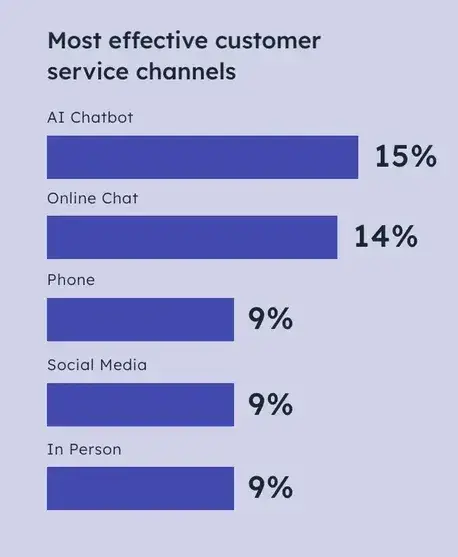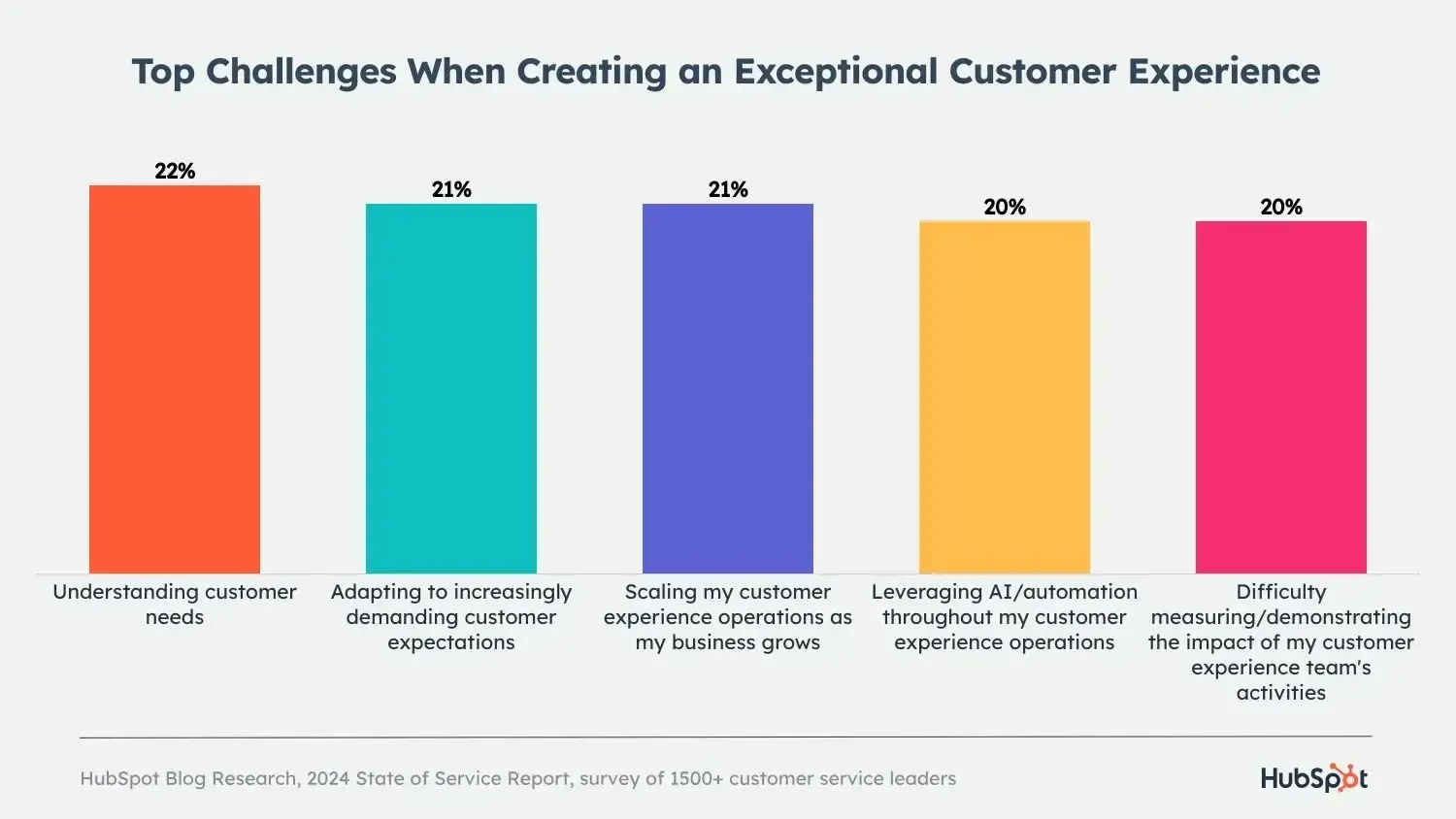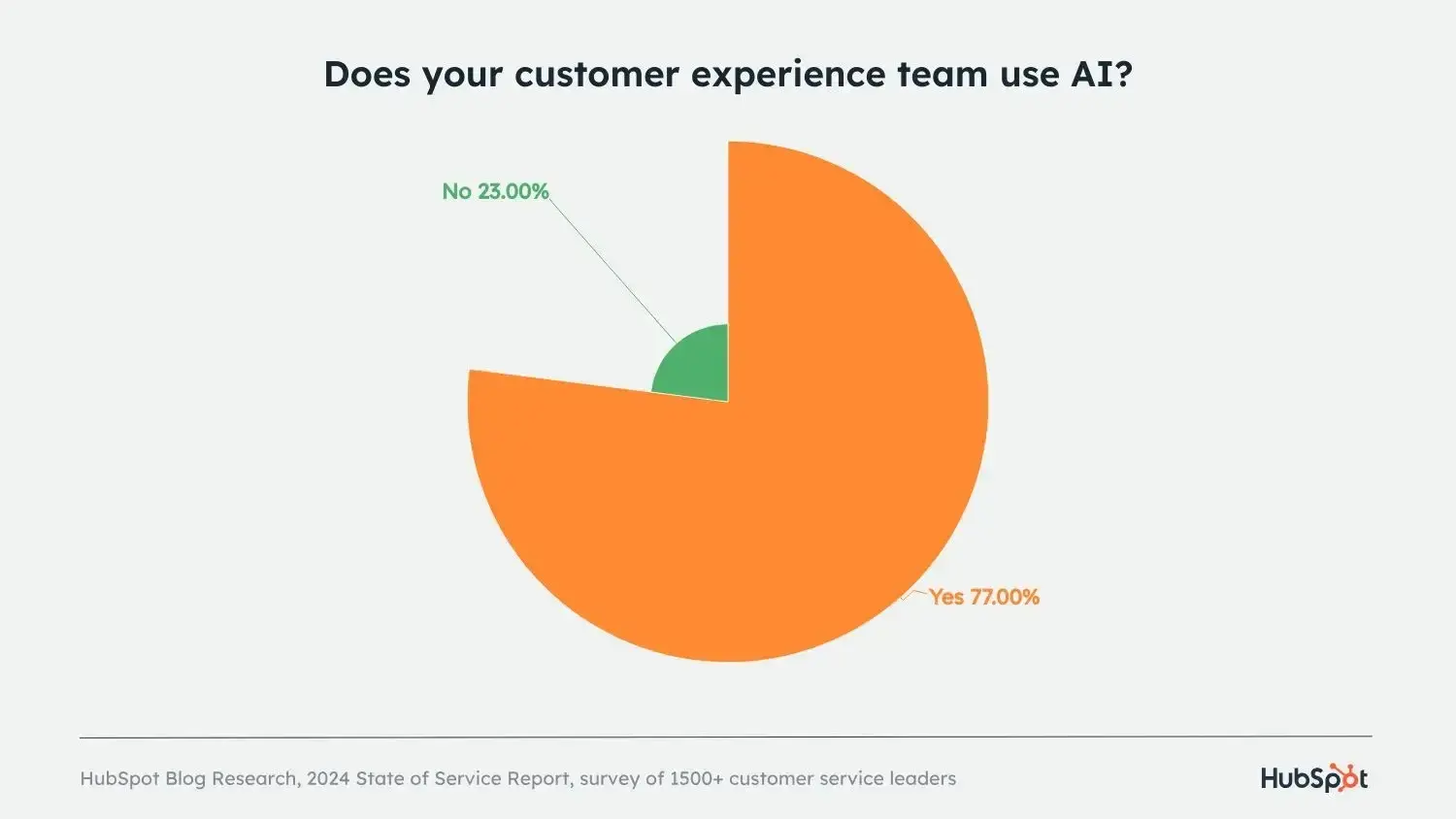Like many, I’m a big fan of buying products online, which means getting packages shipped to my house. When it’s time to check out, I avoid one shipping company in particular. This delivery service has left packages outside my door without my consent, forged my signature, and marked me as “absent” without even attempting delivery. To make matters worse, their customer service line is never answered.
On the flip side, there’s another shipping company I trust completely. They’re reliable and solve problems quickly — often within minutes of the first contact. These two companies provide the same service, so I always opt for the option with a better customer experience.![→ Download Now: The State of Customer Service [Free Report]](https://no-cache.hubspot.com/cta/default/53/9c545446-aacf-47a3-bfb3-1998f78b79c8.png)
Great customer service gives you an edge over your competitors. And, staying on top of the latest trends can help you meet the moment. Check out the customer service statistics that can guide your strategy below.
Table of Contents
- Customer Service Statistics [Report]
- The Importance of High-Quality Customer Service
- The Power of Great Customer Service
- The Best Channels for Customer Service
- Customer Experience Trends
- The Benefits of Using AI/Automation in Customer Service
- Sharing Customer Service Experiences
- The Business Opportunity of Customer Service
- Customer Experience Statistics
- Customer Satisfaction Statistics
Customer Service Statistics [Report]
HubSpot surveyed 1,400 customer service leaders to find out what challenges they’re facing, their goals, and how they use technology to deliver excellent customer service. Download our free report to learn how service teams across the globe deliver on core metrics.
70+ Customer Service Stats to Know
The Importance of High-Quality Customer Service
1. With the rise of AI, 88% of CX specialists view personalization as critical for driving customer loyalty. (Zendesk )
2. 43% of customers said that poor customer service experience discouraged them from buying from a brand again. (Salesforce Research )
3. 75% of customers will spend more on brands that offer good CX. (Zendesk Benchmark data)
4. Over 55% of service and support leaders say they will invest in customer journey analytics to drive more sales. (Gartner)
The Power of Great Customer Service (& The Cost of Poor Customer Service)
5. Poor customer experiences worldwide generate $3.7 trillion in sales risk for businesses. (Qualtrics XM Institute)
6. 88% of customers that good customer service makes them more likely to purchase from a brand in the future. (Salesforce)
7. 73% of consumers say they would leave a company after just one bad experience. (Zendesk)
8. 85% of customer service decision-makers believe that customer experiences will have an increasing impact on revenue. (Salesforce)
The Best Channels for Customer Service

9. 67% of customers who interact with CS bots are surprised how friendly, engaging, and human-like these agents are. (Zendesk)
10. 35% of customers say they‘d prefer to work with an AI agent rather than a human if it meant they wouldn’t have to repeat themselves. (Salesforce Research)
11. 70% of American consumers used phones to contact customer support, yet only 35% of them preferred it over other communication channels. (YouGov)
12. When faced with an unsolvable problem, 70% of Gen Z consumers prefer to make a phone call, just like Millennials and older generations. (McKinsey)
13. Surprisingly, even though email is falling out of favor with company leaders, around 70% of customers still like using it to get help. (McKinsey)
14. 23% of American consumers prefer email, with relatively even usage across generations, though it is slightly more popular among Gen Z (28%) and Millennials (24%). (YouGov)
15. Most customers (72%) want to know when they’re talking to an AI. (Salesforce)
16. 46% of consumers say they are more likely to use an AI agent if they know they can escalate their issue to a human if necessary. (Salesforce)
17. 15% of customer service leaders say AI agents are the most effective customer service channel. (HubSpot, State of Customer Service)
18. Only 4% of people choose social media as a contact method, but it’s slightly more favored by Gen Z (8%) and Millennials (6%). (YouGov)
19. 92% of customer service leaders admit that AI has improved their customer service response. (HubSpot, State of Customer Service)
20. Income level plays a role in how people prefer to get customer service. While the phone is still the go-to for most, higher earners (32%) use it a bit less than those with middle (36%) or lower incomes (37%), leaning more toward email (28%) and live chat (15%) for quicker, digital solutions. (YouGov)
Customer Experience Trends

21. 78% of customers expect more personalization options than ever before. (HubSpot, State of Customer Service)
22. 75% of customer service reps said that they saw the highest ever volume in customer service tickets in 2024. (HubSpot, State of Customer Service)
23. 81% of CRM leaders believe that in 2025 most customer service professionals will already be using AI in their daily work. (HubSpot, State of Customer Service)
24. 44% of CRM leaders say improving CX is the number one pain point they’d like software to help them address. (HubSpot, State of Customer Service)
25. The two most important CX metrics to track according to customer service pros, were CSAT and retention (both at 31%), followed by response time (29%). (HubSpot, State of Customer Service)
26. 32% of customer service leaders use a CRM as their single source of truth for customer experience data. (HubSpot, State of Customer Service)
27. 68% of customer support leaders will focus more on offering customers better tools to solve issues independently. (HubSpot, State of Customer Service)
28. When choosing a customer experience software solution, 40% of CRM leaders expect it to improve data quality, as well as communication and collaboration between teams. (HubSpot, State of Customer Service)
29. In 2024, 64% of leaders stated that they planned to increase their investment in transforming their CRM into a single source of truth. (HubSpot, State of Customer Service)
30. 34% of CRM leaders named improving interdepartmental collaboration as their top CX strategy. (HubSpot, State of Customer Service)
Benefits of Using AI/Automation in Customer Service

31. 86% of service leaders who use AI say that it positively impacted their CSAT. (HubSpot, State of Customer Service)
32. 42% of consumers say that transparency into how AI is used would increase their trust towards AI. (Salesforce Research)
33. 61% of customers feel that as AI technology advances, it’s increasingly important for companies to earn and maintain their trust. (Salesforce Research)
34. Service professionals save more than 2.20 hours a day using HubSpot’s AI chatbot (HubSpot, State of Customer Service)
35. 32% of consumers say that it would increase their trust in AI if they had control over how it’s used. (Salesforce Research)
36. 84% of CRM leaders view AI as a key resource for engaging with today’s customers. (HubSpot, State of Customer Service)
37. 77% of CRM leaders believe that AI will be responsible for resolving the majority of support tickets by 2025. (HubSpot, State of Customer Service)
38. 86% of CRM leaders say AI helps make customer interactions feel more personalized. (HubSpot, State of Service)
39. 15% of customers said that their most preferred customer service channel was an AI chatbot. (HubSpot, State of Service)
40. 65% of CRM leaders believe AI is a more efficient way to scale service operations compared to adding more support staff. (HubSpot, State of Service)
41. 41% of service leaders believe that most customer service professionals will use AI by 2025. (HubSpot, State of Service)
42. AI’s influence on customer service budgets is mixed. 59% of CRM leaders report decreased spending, while 31% say it has increased. (HubSpot, State of Service)
43. 70% of customer service managers worldwide are using generative AI to assess sentiment across a broad range of customers. (IBM)
44. 24% of customers expect AGI to match human capabilities within the next 5 years. (Salesforce Research)
45. AI is capable of resolving between 21–40% of customer requests, with some teams handling up to 80% of all conversations with clients. (Intercom)
46. 75% of CRM leaders say that AI has helped reduce their customer service response times. (HubSpot, State of Customer Service)
47. 73% of CRM leaders plan to invest more budget into implementing AI throughout the customer journey (HubSpot, State of Customer Service)
48. Customer service leaders are seeing an average of 47% of time freed up by AI for value-adding activities for clients. (Intercom)
49. One in two customers (48.8%) say they prefer to interact with a human over AI. (Katana)
50. While in most cases AI doesn’t directly replace staff, 86% of leaders say that it helps their customer service operations scale. (HubSpot, State of AI)
Sharing Customer Service Experiences
51. 83% of review readers say they would avoid a business if they found out it had posted fake or paid reviews. (Yelp)
52. 72% of people who read reviews say they rely on them more than ever when deciding where to spend money at local businesses. (Yelp)
53. 71% of review readers don’t view a star rating alone as a valid review, and 88% say they trust reviews with written comments more than those with just stars. (Yelp)
54. 91% of customer service leaders in 2025 agree that customer expectations towards support teams have grown year-over-year. (Intercom)
55. Nearly one in four (23.29%) of Millennials and Gen Z customers say they haven’t yet had much experience interacting with AI customer support chatbots. (Katana)
56. Even with the growth of AI tools, 88% of review readers are against the use of AI-generated reviews on review sites. (Yelp)
57. 83% of CRM leaders say that AI makes it easier for customer service specialists to resolve customer service requests/tickets. (HubSpot, 2024 State of Customer Service)
58. 21% of men and 37% of women say they’re uncomfortable with sharing personal data with AI chatbots, even if promised a personalized experience in return. (Katana)
59. 55% of consumers are open to choosing a business only if it has at least a 4-star rating. (brightlocal)
The Business Opportunity of Customer Service
60. 83% of consumers use Google to read reviews, making it the top platform by far. Other popular sources include Local News (48%), Yelp (44%), Facebook (40%), and YouTube (34%). (brightlocal)
61. Customer service teams using AI have cut call handling time by 45% and resolved issues 44% faster, resulting in lower operational costs. (Intercom)
62. 68% of C-level support executives report that retaining customers is more challenging now than it was a year ago. (Intercom)
63. 76% of support teams have invested in AI in 2024, though just 54% declared to do so when asked about their plans in 2023. (Intercom) 64. 79% of customer service leaders intend to continue their investment in customer service AI use throughout 2025. ( Intercom)
65. Offering 24/7 support coverage is a top benefit of using AI in customer service, according to 53% of CS leaders. (Intercom)
Customer Experience Statistics
66. 71% of CRM leaders believe that the current customer service experience takes too much time. (HubSpot, State of Customer Service)67. 60% of consumers want companies to adopt voice AI technology. (Zendesk)
68. 61% of customers believe businesses should personalize their experiences with the help of AI. (Zendesk)
69. 67% of consumers expect their customer support ticket to be resolved within 3 hours, while 32% in over 3 hours. (HubSpot, State of Customer Service)
Customer Satisfaction Statistics
70. 70% of customers declare that they see a widening disproportion between the quality of customer service offered by brands that use AI “well” vs those who don’t. (Zendesk)71. 25% of Millennial and Gen Z customers say that they are very comfortable sharing their personal data if it’s going to be used to improve their customer experiences. (Katana)
72. 49% of high performers in customer service rate their customers’ satisfaction as “excellent”, with only 8% of underperformers recognizing satisfaction levels as “poor” (Salesforce)
73. 47% of customer service reps describe their service as “Very personalized,” while 45% describe it as “Somewhat personalized”. (HubSpot, 2024 State of Customer Service)
Customer service is more important than ever
I know this has been said countless times over the years, but customer service has truly never mattered more than it does now. The bar keeps getting raised — not just because the market is saturated, but also because AI has made it a standard expectation for brands to be available 24/7.
As the stats I’ve shared show, customers are less forgiving of long problem resolution times. They can also already clearly see the gap between companies that use AI effectively in customer service and those that don’t. While AI definitely raises the bar for brands, it also makes it easier for you to meet the speed and quality standards customers expect.
Knowing where customer expectations stand today can help you keep up. Good luck!
Editor’s note: This post was originally published in July 2024 and has been updated for comprehensiveness.
![]()


Leave a Reply